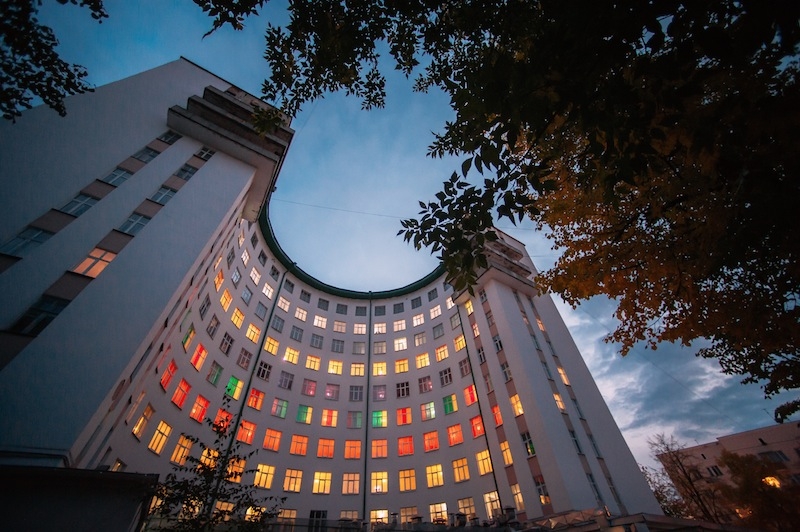A forest of smoking chimneys in the sunset, more than a hundred constructivist buildings and a really interesting biennial – this is a selection of what Russia’s fourth largest city can offer right now. Covered with a thin layer of powdery snow on my visit in late October, Ekaterinburg seems to be part of a story larger than life and yet boiling down to some precise instances of world history in the twentieth century. On the site where Tsar Nicholas II and his family were shot in 1918 are a big onion-domed church and billboard-size photographs of the royals looking down on passersby. A few blocks away the Metenkov House Museum of Photography is hosting an exhibition with mug-shots and other archival material concerning men who were executed in the region during the Stalinist regime of the late 1930s. Another kind of time machine is the newly built palace for the local representative of the president of Russia – it looks exactly like a mid-eighteenth-century Russian mansion, just bigger.
This is the fertile ground of the 3rd Ural Industrial Biennial of Contemporary Art, entitled Mobilization. It refers to efforts towards qualitative improvement of interaction between art and its surrounding reality, to the industrial past and present, and artists’ particular sensibility to the situation. An embedded biennial with a residency programme, collaboration with local industries for the fabrication of artworks, children’s programmes, a performance platform and other events, it forms a powerful presence of contemporary art in an environment where art is rare. The main part of the biennial takes place in the constructivist ‘chekist village’, a part of town with apartments for KGB families and a curved ten-storey dormitory for single KGB officers. Later converted into a hotel (now defunct), this curved building houses many artworks, which inhabit one room each, making the viewing experience one of entering and exiting many small spaces.
Among the works on view are Jonathas de Andrade’s photographs of Brazilian landless workers, whose simple housing is based on the same functionalist principles as constructivist architecture, making a rudimentary alphabet out of sugar cane plants. Pratchaya Phinthong is showing closeups of methane hydrate, an unassuming yet peculiar substance between gas and water with massive implications for future energy development. In one room there is a video shot from the sky showing contemporary Chinese land-art in the form of gigantic slogans marked in the vegetation that say things like ‘surmount every difficulty to bring victory’. In another room a video depicts a man with a torch setting dandelions on fire as he walks quickly across a field.
A special zone in more ways than one, the power plant is simultaneously a site of imminent danger and a second home to the workers, the absolute mundane cohabiting with an invisible threat to life.
The two curators, Biljana Ciric and Li Zhenhua, are responsible for one section each, but given the structure of the building, the sections are easily read together. I stayed the longest in a room belonging to a third section, that of the residency artists. It is the room of Fyodor Telkov, who spent time in the nearby Beloyarskaya nuclear power plant as it was preparing to launch its fourth fast-neutron reactor. The Ekaterinburg-based artist has made an allover installation with plenty of photographs of the complex and its workers, particularly of all the pot plants kept in the workplace. A special zone in more ways than one, the power plant is simultaneously a site of imminent danger and a second home to the workers, the absolute mundane cohabiting with an invisible threat to life.
In this haven of early modernist architecture, most of the constructivist buildings are falling apart. Both the still-active cultural centre in the Uralmash factory complex and the so-called White Tower, originally a water tower, are quickly turning into ruins. This was the heart-land of the Soviet Union, temporarily even named after Lenin’s sidekick Yakov Sverdlov, who allegedly ordered the killing of Nikolai Romanov and his family. Today Ekaterinburg remains an active industrial centre specialising in heavy machinery, including military production. The cityscape features commercial ads on billboards familiar to most consumerist societies and shopping malls. Familiar and strange at the same time, like the faces of the royals and the terror victims on the photographs in the Museum of Photography staring back at us, they exist side by side with large ads for the biennial.
Overwhelmed by my visit to this complex place, and while checking in for my departure flight, I notice a type of sign that I have never seen before: ‘Weapon hand-in/hand-out room’. On the plane to Moscow, I learn about an exhibition happening at the same time as the opening of the biennial: in neighbouring Nizhny Tagil, one of the world’s largest armament displays has just taken place.
This article first appeared in the January & February 2016 issue of ArtReview.
